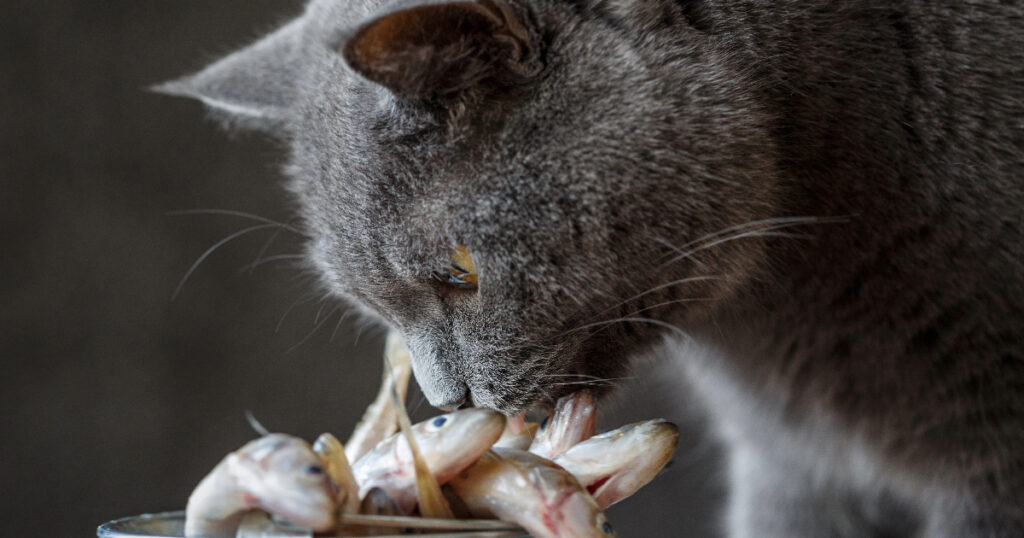As a cat owner, you likely want to give your cat tasty treats from time to time. If you enjoy eating fish like salmon or tilapia, you may wonder if it’s safe to share the fish skin with your cat.

The good news is that cats can eat fish skin in moderation. Fish skin contains important nutrients and can be a healthy supplement to your cat’s regular diet. However, there are some precautions to take before feeding fish skin to cats.
Benefits of Fish Skin for Cats
Fish skin provides several beneficial nutrients for cats:
- Omega-3 fatty acids – Fish skin is high in omega-3s, which are great for your cat’s skin and coat health. Omega-3s reduce inflammation and keep your cat’s skin supple. They also support heart, joint, and brain health.
- Protein – Fish skin is an excellent source of high-quality protein to support your cat’s muscles and tissues. The protein in fish skin is highly digestible.
- Vitamin A – Fish skin contains vitamin A, which is key for your cat’s vision and immune system. Vitamin A also helps maintain skin and coat health.
- Vitamin D – This vitamin aids in calcium absorption for strong bones. Vitamin D is also crucial for nerve and muscle function.
- B vitamins – Fish skin provides B vitamins like niacin and B12. These support your cat’s energy levels, digestion, and cognition.
So by occasionally treating your cat to fish skin, you provide extra protein, fatty acids, and vitamins to supplement their diet.
Risks of Feeding Fish Skin to Cats
While fish skin offers nutritional benefits, there are some potential risks to be aware of:
- Choking hazard – Fish skin can present a choking risk, especially for kittens or cats who gulp their food. Make sure to cut fish skin into bite-sized pieces.
- High in fat – Fish skin is high in fat. Too much can lead to pancreatitis, diarrhea, or vomiting. Only feed small amounts.
- Raw fish toxicity – Raw fish may contain bacteria or parasites dangerous to cats. Always cook fish skin before feeding it.
- Allergies – Some cats are allergic to fish. Look for allergy symptoms like itching, hives, or diarrhea after feeding fish skin.
- Unsafe additions – Avoid fish skin cooked with butter, oil, garlic, or other seasonings that are toxic to cats.
To be safe, introduce fish skin gradually and watch for any adverse reactions. Consult your vet if concerned.
How to Feed Fish Skin to Your Cat

Follow these tips for safely feeding fish skin to your cat:
- Choose a high-quality fresh fish like salmon or pollock. Avoid fish high in mercury like tuna.
- Cook the fish skin thoroughly – baking, boiling, or grilling. Never feed raw fish or skin.
- Check that the fish skin has no bones, which are a hazard for cats.
- Remove any added oils, butter, or seasonings before serving. Fish skin should be plain.
- Cut the skin into small, bite-sized pieces for safety.
- Refrigerate leftover fish skin and use within 2 days. Dispose of spoiled fish safely.
- Introduce slowly – give your cat a tiny piece at first and watch for reactions.
- Avoid daily feeding – fish skin should only supplement your cat’s diet occasionally.
Follow these rules, and fish skin can be a healthy, natural treat for your cat to enjoy!
Can Cats Eat Other Types of Fish Skin?
While salmon and pollock skin are good options, you may wonder about other fish skin:
- Tilapia skin – This is safe but lower in omega-3s than salmon. Make sure it is thoroughly cooked.
- Tuna skin – Feed tuna sparingly due to mercury concerns. Avoid raw tuna skin.
- Cod skin – This mild white fish skin is fine for cats in moderation.
- Sardine skin – These small fish are high in omega-3s. Cooked sardine skin is safe infrequently.
- Mackerel skin – This fish is very high in mercury. It’s best not to feed the skin.
Check with your vet if unsure about a fish, and always supervise your cat when feeding fish skin to prevent choking.
Can Cats Eat Raw Fish Skin?
It’s best to avoid raw fish and fish skin for cats. Raw fish may contain harmful bacteria like salmonella or E. coli that can make your cat sick.
In addition, raw fish contains an enzyme called thiaminase that destroys vitamin B1 or thiamine in your cat’s body. Thiamine is essential for cats to prevent neurological damage.
Cooking fish and skin deactivates the thiaminase enzyme. So always cook fish thoroughly before serving, even if your cat seems to enjoy raw fish. The risks make raw fish and skin unsafe.
Can Kittens Eat Fish Skin?
You should wait until kittens are at least 6 months old before introducing small amounts of fish skin.
Kittens under 6 months are at greater risk for food poisoning. Their digestive systems are more sensitive.
Feed kittens only kitten formula until weaned, then high-quality kitten food until 6 months old. After this age, add new foods like fish skin gradually.
Also, cut fish skin into tiny pieces for kittens to prevent choking. And as always, cook fish skin before feeding. Monitor your kitten closely when first trying new foods.
How Much Fish Skin Can Cats Eat?
Fish skin should only be an occasional treat, not a regular part of your cat’s diet. Follow these serving guidelines:
- Adult cats – Feed 1-2 small pieces around 2.5-5 cm long per day. Offer fish skin a few times per week at most.
- Kittens – Give just a tiny pinch of fish skin, about 1 cm long. Wait until 6 months to introduce.
- Overweight cats – Give just one small piece twice a week. Adjust as needed to aid weight loss.
- Older cats – Try a pinch or one small piece to start. Check kidney function if concerned.
Do not replace regular meals with fish skin. It is not nutritionally complete for cats. Monitor your cat for any digestive upset.
Can Cats Eat Fried Fish Skin?
You should avoid feeding your cat fried fish skin, even in moderation. Frying makes the fish skin much higher in fat, oil, and calories compared to baked or boiled skin. Too much-fried food can lead to obesity and pancreatitis.
Fried fish skin may also contain seasoning or salt from the oil or batter used in frying. Onions, garlic, and other seasonings can be toxic for cats.
While the occasional tiny piece may not harm your cat, fried fish skin provides no nutritional advantage over boiled or baked. It’s best to stick to plain cooked fish skin instead.
Key Takeaways on Fish Skin for Cats
To recap, here are the key points for feeding fish skin to cats:
- Fish skin provides beneficial omega-3s, protein, vitamins, and minerals.
- Only feed cooked fish skin in small amounts occasionally. Avoid raw.
- Monitor for allergies, pancreatitis, and other reactions.
- Cut into bite-sized pieces and supervise to prevent choking.
- Introduce fish skin slowly, especially for kittens under 6 months old.
- Do not replace regular cat food with fish skin or feed daily.
- Fried fish skin is too high in fat and salt for cats compared to baked/boiled.
So with some care and moderation, fish skin can be a healthy supplemental treat for your cat’s diet. Check with your vet if you have any concerns about appropriate foods for your cat.
FAQ
Can I give my cat fish skin every day?
No, fish skin should only be fed occasionally as a treat, not daily. Fish skin is high in fat and does not provide complete nutrition. Feeding fish skin every day can lead to nutritional imbalances or obesity in cats. Vets recommend limiting human foods like fish skin to only 10-15% of your cat’s diet at most.
Is cod skin safe for cats?
Yes, cod skin can be safely fed to cats in moderation. Cod is a lean white fish that is low in mercury. Make sure the cod skin is thoroughly cooked with no added flavors or spices before feeding it to your cat. Introduce slowly and give cats just a small piece at a time, a few times per week.
Can I give my cat raw mackerel skin?
No, do not feed your cat raw mackerel skin. Mackerel is very high in mercury, so both the raw skin and meat can be toxic to cats. In general, raw fish and fish skin should always be avoided for cats due to bacteria risks. If feeding mackerel, cook it fully and remove all bones before giving your cat a tiny portion of the meat.
Is fish skin ever dangerous for cats?
Fish skin is not inherently dangerous, but there are some risks to be aware of. Raw fish skin can contain harmful bacteria, parasites, and enzymes. Fish bones can also be a choking hazard. Too much fish skin may lead to nutritional imbalances. Introduce new fish slowly and feed only cooked plain fish skin in moderation under supervision. Consult your vet with any concerns.
Can kittens eat tilapia skin?
No, kittens under 6 months old should not eat any fish skin, including tilapia. Kittens have sensitive digestive systems and weaker immune defenses. Wait until your kitten is at least 6 months old before introducing small amounts of cooked plain fish skin. Even then, feed only tiny pieces to kittens and supervise them closely to prevent choking.
Conclusion
Fish skin can provide healthy fats, protein, and key vitamins to cats in moderation. However, it’s important to cook fish skin thoroughly and remove any bones or seasoning before feeding it. Introduce fish skin gradually and avoid feeding it daily, as too much can lead to obesity or digestive issues.
Monitor your cat for any signs of allergies or illness after eating fish skin. With some care, fish skin can be a beneficial occasional treat, but be sure to consult your vet on appropriate diet options for your cat.








